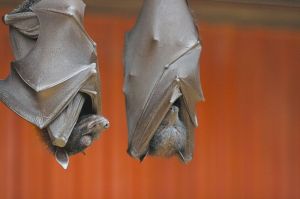
As a child, I spent a great deal of time at the dentist. My mouth was a construction project that at the beginning seemed futile. I had every type of brace imaginable. But like most episodes of Grand Designs, it all worked out in the end.
Why am I telling you this? One of the nicest parts of going to the dentist when I was little was being able to gawp at the tank of tropical fish they had in the waiting room. But there was something that always bothered me about fish. I’d never seen one that was asleep.
The problem really, was that I hadn’t grasped that “sleep” can be quite different between species, which raises some very interesting questions about the importance of it.
Humans sleep a lot
We spend a considerable amount of time sleeping. On average, humans spend about 8 hours per day sleeping, which equates to a third of our lives. However, throughout our lives the times we spend in the different stages of sleep changes.
We are sent to sleep by chemicals called neurotransmitters that are released in the brain and act upon certain groups of neurons. Sleep itself then encompasses several different stages, which can be divided into REM (rapid eye movement) sleep, and non-REM sleep.
We usually have around three to five episodes of REM sleep per night. The brain is very active during these episodes, and is thought to be when most dreams occur. Our eyes move very fast, our breathing rate and blood pressure is elevated. Non-REM sleep, by contrast, is when we have slowed muscle activity, breathing patterns and heart rate. During a part of non-REM sleep, the brain begins to produce delta waves or slow waves – these can be measured using an EEG.
Children spend about 50% of sleep in REM sleep and 50% in non-REM sleep, whereas adults spend about 20% of sleep in REM and 80% in non-REM. For older people, this shifts again to about 15% of sleep in REM sleep.
Sleep times vary wildly in well, the wild

Bats sleep for a massive 20 hours a day. Giraffes, donkeys and cows on the other hand, sleep for less than 5 hours a day.
Scientists have been trying to identify trends in sleeping patterns. Some emerge, such as correlations with diet, body mass and brain size. For example, herbivores seem to sleep the least when compared to carnivores and omnivores, though it isn’t clear why this might be.
Marine animals such as dolphins, whales and manatees are stranger yet, as the characteristic waves of sleep that we can measure have only been detected in one brain hemisphere at a time, with the curious effect of sleeping with one eye open, the other shut.
It only gets stranger. Fur seals can do both – while in the water, they show the “unihemispheric slow waves” that whales and dolphins have. The flipper opposite to the “awake” part of the brain flaps around to maintain the seal’s position. However, when on land, the Fur seal’s sleeping patterns almost instantly change to those more similar to terrestrial animals, with slow waves being recorded in both brain hemispheres.
We are of course assuming that the lack of slow waves means “sleep” is not occurring. Fundamentally, we need to address whether the essence of sleep is the same in terrestrial and marine animals – the latter clearly need to remain at least partially alert all of the time in order to keep swimming and avoid obstacles, whereas we can remain in one place.
Studies on sleep in fish and more simple organisms are quite difficult to interpret – some certainly don’t seem to exhibit the classic characteristics of sleep. Zebrafish show changes in responsiveness and activity at various times of the day, which led researchers to define a “sleep-like state”. The fish tended to hang around at the bottom of the tank, and have decreased activity at night. In addition, disrupting the hypocretin system, the hormone system disrupted in narcolepsy, showed a decrease in the time spent in their sleep-like state. Sleep-like states have also been defined in insects, such as the fruit fly, where disrupting their rested state impairs their cognitive and learning abilities.
The Importance of Sleep
It is logical to assume that sleep must be important, simply because the lack of it causes our bodies to try and recover the lost amount by sending us to sleep during seminars. Research in the 90s showed that lack of sleep can be fatal – in rodents at least, it caused death more quickly than food deprivation. On a cellular level, evidence has surfaced recently that sleep deprivation causes neuronal death.
Different stages of sleep are thought to be important for different things. Deep sleep, which is non-REM and only lasts for a few hours, is thought to be the time for memory consolidation – the movement of short-term memories into long-term storage. This probably accounts for why sleep-deprived individuals are more forgetful, and also likely to be the reason why a good night’s sleep is a great idea before an exam.
The link between sleep and memory consolidation has been elegantly shown in mice, by studying the hypocretin system I mentioned earlier. When the hypocretin system is active in our brains, it wakes us up. Scientists have manipulated this system before in mice so that the mice wake up every minute. These mice show significant memory defects when presented with a task compared to mice who were not woken up every minute. However, mice that were woken up every two minutes did not experience this problem. The sleep cycle of a mouse is around 9 minutes, which is significantly shorter than ours, so this study seems to show that continuity of sleep is important for mammals, rather than short bursts.
In addition, deep sleep correlates with higher rates of production and breakdown of proteins in the body’s cells – meaning deep sleep might quite literally be your “beauty sleep”.
REM sleep is the only time in our lives where the stress-related chemical noradrenaline is completely switched off. It’s thought that this allows us to remain “calm” and process our emotions and experiences of the day. The areas of the brain involved in learning are very active, which means REM sleep could be very important for child development.
So why are sleeping patterns so different between species? It’s not a stretch to imagine that the type of sleep might vary simply because more simple organisms don’t experience or process emotions in the same way that we do. Whether or not animals go through REM sleep or not varies – most mammals and birds show signs of REM sleep, whereas reptiles and other cold-blooded animals do not seem to. Another theory is that sleep times have evolved differently in different species due to a variety of external and physiological factors – for example grazing animals may sleep less because they need to spend so much time eating. Other land animals may sleep less because of vulnerability to predators.
Whatever the reason, we clearly need to further our understanding of what sleep is and its importance.
Sources & Links
Jerome M. Siegel (2005). Clues to the Function of Mammalian Sleep. Nature. – A review about some of the differences in sleep between different animals. Includes a nice chart showing sleep times. Think you need institutional access.
Allan Rechtschaffen (1998). Current perspectives on the function of sleep. Perspectives in Biology and Medicine. Talks about some of the work in rodents and sleep.
Yogogawa et al. Characterisation of Sleep in Zebrafish and Insomnia in Hypocretin Receptor Mutants. PLOS Biology. – work on sleep in zebrafish
Rolls et al. Optogenetic disruption of sleep continuity impairs memory consolidation. PNAS – the experiments carried out looking at sleep continuity in mice.
http://www.bbc.co.uk/news/magazine-20340562 – things people do in their sleep….
